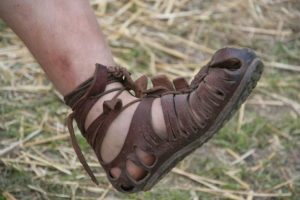We all learnt to walk very young, normally in the second year of life. It’s completely automatic. Severely neglected babies in orphanages ( update - assuming they are physically normal, see comments /update) get up on their feet and walk (Bowlby, 1952, page 20) just as soon as the adored princelings of modern parents, who cheer on every step with praise and console with hugs after every fall. As with any self-taught skill, our methods are approximate, and we stick with what works.
Skills acquired like this can often be improved. Here is a tip sheet from British sports scientist and walking guru, Joanna Hall.
Ms Hall has a system to sell. If you can’t be bothered to wade through it all, here is the RBC tl;dr condensed version in two bullet points.
- Pay attention to your trailing foot. Roll it forward and consciously give a little extra push. The little push, at a roughly 45 degree angle, will make your posture more upright and your gait faster. It puts the proverbial spring in your step.
I’ve tried this and it works. More’s the point to the sedentary and egghead RBC readership, it reflects psychological and physical principles. Intuitively, we believe in the impetus theory: in walking, it’s throwing your leading foot and the opposite arm forward that moves us onward. The impetus theory is wrong. By Newton’s laws of motion you cannot accelerate the centre of mass of your body by swinging a part of it forward.
You can see this more clearly with a thought experiment. You are an astronaut in space, and you have just lost your tether to the spaceship. How can you get back? You can’t do this by motions with any part of your body, however energetic. Swimming is impossible in a vacuum, and you have nothing to push against. Your best bet, if I get Newton right, is to rotate – swinging one arm should turn your body the opposite way – until you are facing away from the spaceship. Then throw non-essential pieces of equipment to your front as hard as possible. The reaction will slowly move you back towards the ship.
The only part of the body that can possibly move you forward in walking is that in contact with the ground, viz. the trailing foot. This exercises a force against the ground, the reaction against which is forward motion. The only effect of moving your leading foot forward when you walk is to prepare a new point of contact.
- Buy shoes with flexible soles. These allow the natural flexion of the foot round the ball. Rigid soles frustrate this, and make walking harder.

Reconstruction of a Roman legionary caliga (Wikipedia)
There is a historical objection to this. From the Roman legionaries to the Gulf Wars, armies have equipped their infantry with stiff-soled footwear. Did they get it wrong, or is it Ms Hall, Isaac Newton and me? I’m sticking with Newton. I suggest that the armies had two reasons.

US Army Schwarzkopf desert boot
The first was that they gave priority to protecting the feet of soldiers on rough ground and allowing them a firm stance when wielding weapons, often quite heavy, and often with considerable force. The second is that before the arrival of vulcanised rubber soles in 1876, there was no realistic alternative to leather, which is pretty stiff when thick enough for a shoe sole. But there is no excuse today not to get a flexible rubber sole.
General Norman Schwarzkopf, who designed a traditionally massive desert combat boot for the US Army, has soulmates in an unlikely place: the baby shoe industry. Their sturdy products offer splendid protection against Lego IEDs, biscuit crumbs,

Typical toddler shoe
furniture, dogshit, and other hazards. But they don’t help toddlers to walk. The
advice of professionals (here, here) is to leave them off indoors as much as possible. The infant’s problem when she levers herself up for the first time is that her foot muscles are soft from lack of use. So she falls down. That is absolutely inevitable and part of the learning process. The learning will presumably be shorter if the complex foot muscles and ligaments are put quickly to use, by natural walking.
Nancy Sinatra puts boots to double use.
Leave a Reply
You must be logged in to post a comment.